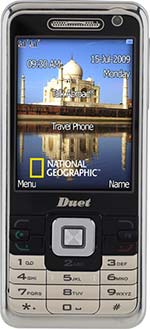National Geographic "Duet"
D888 Travel Phone
Archived Article
by Durant Imboden
 Cellular Abroad,
a U.S.-based company that sells and rents mobile phones to international travelers,
is currently featuring the National Geographic Duet Travel D888 Phone, the first FCC-approved
handset that supports two SIM cards. Cellular Abroad,
a U.S.-based company that sells and rents mobile phones to international travelers,
is currently featuring the National Geographic Duet Travel D888 Phone, the first FCC-approved
handset that supports two SIM cards.
The Duet D888 phone comes with National Geographic's prepaid SIM
card, which offers free incoming cards in more than 70 countries and outgoing
calls at competitive rates in 200+ countries.
The multiband GSM phone
works with mobile networks on six continents--and
because it's "unlocked," you can use it with a SIM card from your existing
GSM carrier (such as AT&T or T-Mobile) as well as the National Geographic
Talk Abroad multi-country SIM card or single-country cards from Cellular Abroad and local
vendors. (The price for the phone plus the Talk Abroad SIM card is US $179,
which includes approximately 30 minutes of outbound calling time.)
The Duet includes other features for travelers, such as
dual-line Bluetooth, a camera, an FM radio, mobile TV (outside the U.S.), a
plug-in memory card, and
National Geographic content such as travel videos and ringtones. However, the
phone's real claim to fame is its support for two SIM cards, which can be useful
in several ways:
-
You can use the National Geographic SIM card (or a
single-country SIM card) for outgoing calls and for free incoming calls from
friends and family while traveling, but other people--such as business
callers--will still be able to reach you via your regular number if you've enabled global roaming for your domestic phone
plan.
-
If you plan to spend considerable time in one country, you
can use the National Geographic SIM card in one slot (for incoming calls and
calls from other countries) and a single-country SIM card in the other slot
(for cheap outgoing calls and free incoming local calls within the country
where you're doing most of your travel).
-
When you're back in the United States, you can use the D888
as a combined "two numbers in one" personal and business phone if you have
accounts with carriers such as AT&T and T-Mobile that use the international
GSM technology standard.
In 2009, I tested the Duet D888 on two separate trips: a cruise
in Scandinavia, and another cruise in the Eastern Mediterranean. I encountered
only one minor problem, which was easily rectified by turning on "extended
roaming" for Italy, as suggested by Cellular Abroad's customer support.
Otherwise, the phone and the current-generation National Geographic Talk Abroad
SIM card worked perfectly, once I figured how to open the phone and insert the
SIM card. (The instruction manual should have included the sentence, "Don't be
so nervous about breaking the phone when you slide off the battery cover.")
I should mention that I've been using Cellular
Abroad's multiband phones, single-country SIM cards, and first-generation
Talk Abroad package for more than five years. Having
an international mobile phone in my pocket offered a lifeline to home (and made
it far simpler to rebook my homebound flight) when a minor stroke induced by the
strap of a heavy camera bag pressing against my neck landed me in an
Italian hospital for 18 days in 2006.
Should you buy the Duet D888 phone? I'd say that depends mostly
on how much you value the convenience of having two SIM cards. (If you're an
infrequent mobile-phone user like me, you may be just as happy with a simple,
minimalist, big-buttoned cell phone from the early 2000s--providing you're
willing to live with incredulous stares from today's more sophisticated phone
users.)
For more information about the Duet D888 phone, visit
CellularAbroad.com.
| |
|